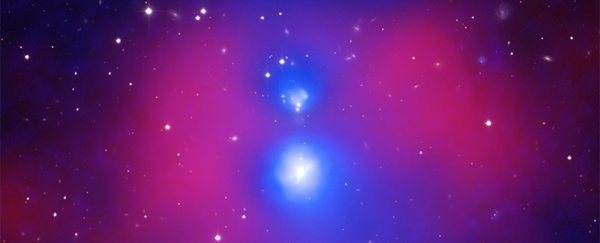Astronomers are keeping a close eye on what they say could be the most violent collision of galaxies ever observed, with two groups of galaxies currently coursing towards each other at around 6.4 million kilometres (or 4 million miles) an hour.
The two groups of galaxies are on the way to forming a larger group known as a cluster, and researchers think this spectacular slamming match could reveal invaluable insights into how such clusters grow and evolve.
All this is happening around 380 million light-years from Earth, in a system called NGC 6338. Its total mass is estimated to be somewhere around 100 trillion times that of the Sun – 16 percent of that is hot gas, 1 percent is stars, and the other 83 percent is thought to be dark matter.
Enlisted to help record the event for posterity are the Chandra X-ray Observatory operated by NASA and the ESA's XMM-Newton up in space, plus the Giant Metrewave Radio Telescope (GMRT) and the Apache Point Observatory down on the ground.
"The NGC 6338 system provides an excellent example of both rapid radiative cooling and violent merger processes at the group scale," the team writes in a study documenting this collision.
It's not just the speed of the galaxy collisions that makes NGC 6338 special, but the heat, too: The hot gas in the system is reaching around 20 million degrees Celsius (a little over 36 million degrees Fahrenheit).
The latest data reveal regions of gas being heated by shock fronts, created in a similar way to sonic booms by waves of energy travelling at incredibly high speeds – in this case it's happening as the galaxy groups collide. This heating had been predicted by computer models before, but has now been observed for the first time.
What's missing is heat generated by supermassive black holes; this heat source is commonly found in galaxy groups and clusters, but it appears to be missing in NGC 6338.
Galaxies often clump together in groups or clusters, pulled together by the effects of gravity, and astronomers have plenty left to learn about the strange physics of such massive congregations. The largest clusters can contain thousands of galaxies. (Just think about it for a second.)
Scientists have already found galaxy clusters helpful for probing the mysteries of dark matter, using starlight between the clusters to map out where dark matter might be hiding.
Astronomers are also interested in the magnetic fields stretching between and within galaxy clusters. These bridges of radio-emitting plasma are hard to detect, but can teach us more about the gravitational pull of these big groups of galaxies.
The clustering of galaxies also affects star formation because of the forces at work, so with another cluster on the way to being created in NGC 6338, astronomers will be eager to find out what else they can find out.
The research has been published in the Monthly Notices of the Royal Astronomical Society.
